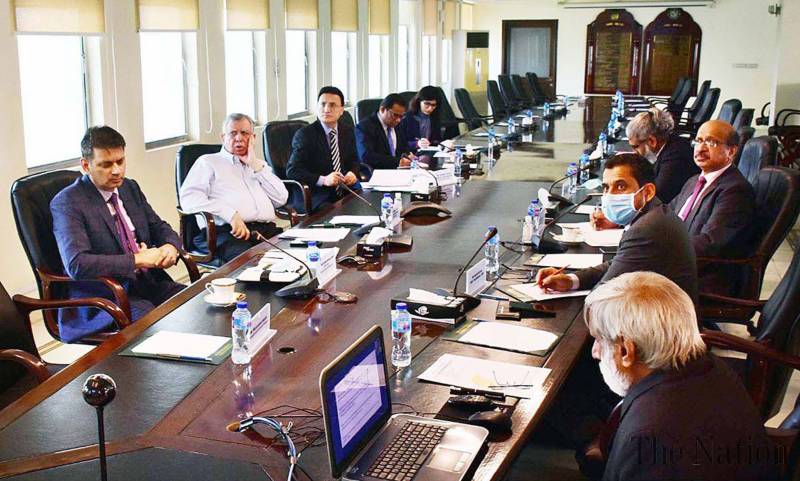To achieve the growth target of financial year 2022, the economy is on the right track, according to Finance Minister Shaukat Tarin.
The Ministry of Finance on Monday noted that there are some risks to the economy associated with rising international commodity prices, widening of the current account deficit and subsequent pressure on Pakistani rupee.
“The economy of Pakistan is on track to achieve the growth target for FY2022. The 2nd estimates of the cotton crop along with the latest performance of high frequency variables are encouraging and set an optimistic baseline scenario. However, there are some risks to the economy associated with rising international commodity prices, widening of the current account deficit and subsequent pressure on PKR,” said Ministry of Finance in its Monthly Economic Update & Outlook November 2021. It noted that though economic recovery is underway, the economy is also confronting inflation as well as external sector pressure. The acceleration of worldwide inflation, as well as a significant increase in freight charges making international trade more costly.
It noted that inflation is marginally increased in the last two months. Going forward, this increase in inflation may be tempered by the seasonal profile whose contribution was positive in October but is usually about neutral in the months of November. Furthermore, government’s policy, administrative and relief measures may support to ease out the inflationary pressures. On the other hand, new impulses in November may originate due to the rise in international commodity prices. Globally the prices of crude oil along with all other energy inputs are on the rising trend due to increasing global demand post-COVID-19 scenarios. Added with this, a rise in freight charges have made international trade costly and caused a hike in global inflation. Even though the international price of crude oil rose by 106.7 percent on a YoY basis. However, Government of Pakistan did not pass it completely to the domestic consumers and adjusted duty to provide relief to the general public. At present government aims to increase agriculture productivity and provision of agri loans to ensure food security and self-sufficiency to counter the food inflation. Taking into account new price impulses in November and the low base effect, it is expected that inflation may remain 8.5 to 9.5 percent.

Exports of goods and services, according to BOP data, ended just below the 3 billion USD mark in October. It is expected that in the coming months, these exports will start moving upwards again, helped by the momentum in domestic economic dynamism, specific government policies to stimulate exports and from a historical perspective, low level of the Real Effective Exchange Rate. But these dynamics may be hindered if the economic conditions in the main export markets would take a turn for the worse, although this is not the baseline scenario. As a result of these events, the trade deficit in goods and services increased somewhat as compared to level observed in September but is expected to improve in the coming months. If remittances inflows remain at around current levels and given the expected other components of secondary income, as well as primary income balance, the expected improvement in the trade balance will be reflected in the overall current account balance. This is the baseline scenario and further ongoing developments will be monitored closely.
The fiscal performance remained strong during the first quarter of the current fiscal year on the back of healthy growth in tax revenues, careful expenditure management and higher provincial surplus. The fiscal deficit narrowed to 0.8 percent of GDP in Q1 FY2022, down from 1.1 percent last year, as revenue growth outpaced the growth in expenditures. Within revenues, FBR tax collection has witnessed a sharp rise during Jul-Oct FY2022. FBR is highly committed to further improve the tax collection through documentation and maximum taxpayer’s facilitation. Government is proficiently dealing with COVID-19 challenges through timely effective measures. It has speed up the vaccine process so that the economic activity remains on track without any disruption. While increasing expenditure on priority areas, the government is adhering to a strict spending management strategy. On the one hand, the government has increased the spending on growth-oriented projects, while on the other; it is focusing on bolstering the social safety net through various Ehsaas poverty alleviation programmes.
The current fiscal performance reaffirms the government’s commitment to strike a balance between fiscal deficits due to COVID 19 and boosting the growth of the economy, keeping the primary balance at a sustainable level, and protecting social spending. The government’s efforts to maintain fiscal discipline through an effective revenue mobilization strategy and better expenditure management will continue to aid in further reducing the budget deficit during the current fiscal year.
Pakistan is on a high growth path. At the same time, it is confronted with persistent inflationary pressure. The level and degree of persistence of inflation is the consequence of depreciation that followed the previous balance of payments crises, reinforced by the acceleration of worldwide inflation and the exceptional surge in international commodity prices.
These events put a lot of stress on the external accounts, more specifically on the balance in trade of the goods and services and from there on the current account balance. Government aims to alleviate this stress as much as possible by implementing structural measures as well as by demand policy management. In terms of demand management, fiscal consolidation, while protecting the vulnerable sections of the population from the surge in food and energy prices, is the main objective of fiscal policy. At the same time, SBP is redirecting monetary policy from an accommodative to a more neutral stance.
These measures should contain the current account deficit for the current FY within manageable and financeable proportion. This will also help to adjust pressure on the exchange rate and hence on expected inflation. Moreover, IMF has also acknowledged that based on available data, the government’s extensive policy response to the COVID 19 pandemic had helped minimize its human and macroeconomic repercussions and thus resulting in a strong economic recovery. External pressures, on the other hand, have begun to materialize, mostly due to the compound impacts of increased economic activity, an expansionary macroeconomic policy mix, and rising international commodity prices. However, due to the measures taken by the government will ease out these pressures in coming months.






